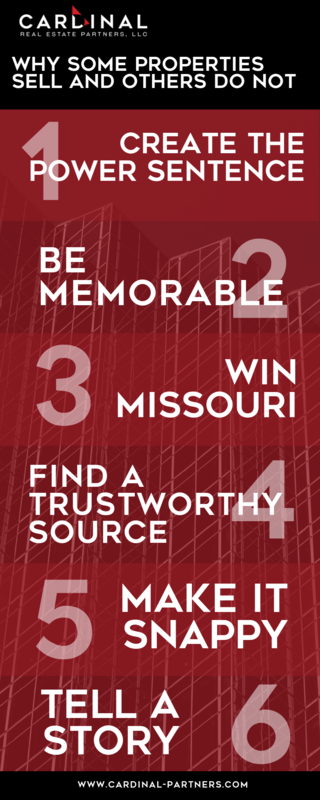Recent current events have reminded me of the Mark Twain observation: “A lie can get halfway around the world before the truth can even get its boots on.” The power of a “sticky” sound bite or story can be very effective when trying to attract attention to an idea, and it works when selling real estate.
I’ve sold some very challenging, complex real estate assets ranging from a coal mine to a sports coliseum to large land tracts. One property even had an underground fire raging. Putting the right spin on the potential strengths and obstacles that these properties possessed is an art form that my team was uniquely adept at.
Unfortunately, brokers often rush through the marketing effort in a hurry to get the property on the market. Such marketing lacks authenticity or comes off as unoriginal and is not effective in highlighting the property’s potential or emotional appeal. In these fumbled marketing efforts, the clear target market is not identifiable, and the result is a lack of interest.
So, what’s the best way to tell a real estate story?
My friends in the residential real estate industry do it very well. I have studied how community developers such as Del Webb with their Sun City communities are awesome at telling stories and creating strong emotional appeals.
Combining those observations, and reading marketing books such as the Heath brothers’ Made to Stick, and combining their tips with my own practices, I’ve come up with the following steps.
Create the Power Sentence: Start with one simple sentence that says it all. This is a very simple, one sentence value proposition for the asset. You should have a comprehensive understanding of the real estate asset thanks to the due diligence you’ve collected. When writing my value proposition, I’ll often start with a few paragraphs, and then after working for 15 or 20 minutes I can get it down to a power sentence.
- Be Memorable: What is surprising about your Power Sentence? If you can be surprising or catchy, you can’t be forgotten. This means coming up with something unexpected that drives home this simple sentence, because the unexpected is what people will remember.
- Win Missouri: Ah! the “show me” state. If you win over these people, you have potential. These represent your readers who are skeptical and require very powerful, concrete data to drive home your simple point and your unexpected claim. People receiving real estate marketing information are naturally skeptical and you have to have some very powerful, concrete data to drive home your point.
- Get Tom Hanks to endorse your idea: According to separate surveys done by both Forbes and Reader’s Digest, Tom Hanks is the most trustworthy figure in the nation. If Tom Hanks is in favor of your idea, it must be a good one. Find a trustworthy source that backs up your value proposition. For example, information from Reuters, or someone whom the reader will accept as being an expert making a quote about the property or asset. It is important that the source is viewed as highly credible who is supporting your claim.
- Make it snappy. Missourians may only want to see data, but the rest of us will not read an ugly marketing appeal. Once you have the pieces, the value proposition, the data, the sources, and the unexpected twist, you’ll need to put it together in a way that is visually appealing. Regardless of the format, whether you are going digital or print, graphics and wordsmithing matter. There are resources out there that can help you DIY, or find a team of professionals like Backstage whom you can trust to take your ideas and voice and create the story you want to tell.
- Tell a story: This the most important step. Why? Because a good story will simplify a complex deal. Southerners are great at telling stories to drive home a point, and by following these steps you can create a very powerful story that drives home your message about your asset. And this is where it gets fun – because if you are really, really good, you can weave into your story telling something that reminds people that what you are selling has a positive impact on their lives.
Ultimately, by combining steps 1 through 6, you’ll be able to say something compelling about your asset that will ideally be memorable and make the asset mean something to that one buyer. If nothing else, just get the details right, get some pretty pictures and tell a story about yourself about why you personally love the asset.
It’s hard to do, admittedly. But we’ve seen the residential community succeed at this by inspiring people to think that a structure is a phenomenal place to raise their family, or where they want to have holidays with their kids.
And yes, that kind of family warmth is hard to capture in commercial real estate. But using creative storytelling is how Cardinal packages everything we sell. And it’s why we’re the best in the world at creating and selling complex assets.
Want to learn more about how we at Cardinal tell our CRE stories? Contact us or check out Backstage.


 Create the Power Sentence: Start with one simple sentence that says it all. This is a very simple, one sentence value proposition for the asset. You should have a comprehensive understanding of the real estate asset thanks to the due diligence you’ve collected. When writing my value proposition, I’ll often start with a few paragraphs, and then after working for 15 or 20 minutes I can get it down to a power sentence.
Create the Power Sentence: Start with one simple sentence that says it all. This is a very simple, one sentence value proposition for the asset. You should have a comprehensive understanding of the real estate asset thanks to the due diligence you’ve collected. When writing my value proposition, I’ll often start with a few paragraphs, and then after working for 15 or 20 minutes I can get it down to a power sentence.




